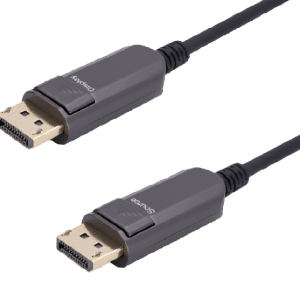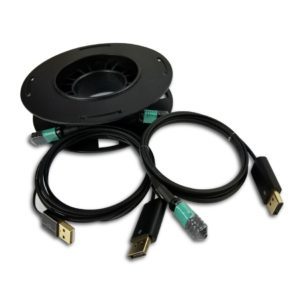Video extenders have evolved a great deal since they first came out in 1999. But despite the increasingly sophisticated technology, one many of us take for granted, one thing remains the same: the material construction of the extender and cables makes a huge difference in the quality of signal transmission. Clearly you don’t want to lose your connection in the middle of an important meeting or while interpreting or administering a CT scan.
Video Extender Explained
A video extender enables a video and/or audio signal to be transmitted over distances or extends the distance you can clearly transmit a signal. Initially constructed of copper, DVI video fiber extender came out in 1999 and was only capable of transmitting video. HDMI, which could transmit both video and audio, followed a few years later. Both became staples in television and audio-visual equipment.
DisplayPort, a more sophisticated extender with more capabilities, came out a few years later and quickly became popular, especially in applications that need high resolution imaging. Relied on in medical facilities, labs, and pharmaceutical companies who use imaging scans that require great detail, high resolution, video extenders when used for those purposes often must pass rigorous medical certification requirements.
The materials in cables – i.e. copper, fiber, or a hybrid of both, can determine the suitability for a specific industry application, its compatibility with other technology, the quality of the signal, how far it will go, and ultimately the price you pay. Choosing wisely can help you avoid costly mistakes. It breaks down this way.
Copper Video Extender
Copper cables were the backbone of the first video extenders on the market.
Copper is:
- less expensive
- consumes less power
- has lower latency
- sturdy and powers up easily
But the main disadvantage is copper can only transmit reliable signals for a distance of about 50 feet.
Over long distances, copper cables experience heavy signal loss. Also, the further distance a copper cable goes, the heavier the cable gets. You can’t bend it. It also doesn’t provide electronic security.
Practically speaking, most video extenders made strictly of copper would not work for commercial or industrial use unless a very short signal was all that was required. They are still a staple for home or residential use and also for audiovisual applications that run very short distances (not for professional AV, though).
Fiber Video Extender: Ideal for Long Distance
Extending a video signal over fiber results in capability to transmit the furthest distance. Vitex LDP series DisplayPort Extenders, for example can transmit DisplayPort signals up to a distance of 1000 feet.
In addition to their ability to transmit long distance, pure fiber extenders have many other advantages. They
- are not affected by electromagnetic interference and/or crosstalk;
- are lightweight, durable, and easy to bend: fiber cables can weave through small nooks and crannies when installed;
- provide secure communication;
- supports high resolution video or visuals with picture clarity at resolutions of 8k;
- have greater bandwidth, which means you can transmit more information.
Disadvantages of fiber include:
- It costs more than hybrid cables or pure copper;
- It’s not always compatible with other displays and video cards. Additional programming may be required to configure the extender.
Hybrid Video Extender
Hybrid cables or Active Optical Cables are a composite of fiber and copper but predominantly fiber.
Some advantages of hybrid cables are:
- A hybrid extender is less expensive than pure fiber;
- They provide greater compatibility with other electronics. The copper in the component facilitates an “EDID handshake.” That means plug-and-play is automatic;
- The fiber component in the cable provides greater electronic security;
- You can send clear signals longer distances as compared to pure copper cables (but not as compared to pure fiber);
- The cables are robust.
On the downside, they are not practical for applications requiring long transmissions. They are not as adaptable as fiber when technology changes.
They are a good option and a popular choice for applications that don’t require extremely long-distance transmission. A hybrid cable which can transmit clearly for 190 feet is a reasonable choice, such as for gaming, virtual reality, simulation training, contexts where they’re widely used.
Conclusion
To optimize the performance of your video extender and ensure it meets your specific needs, you should consider the materials used in construction.
To choose between pure fiber or hybrid or copper, these variables should guide your choice:
- What distance do you need to transmit your video or audio?
- What level of electronic security do you need?
- What resolution do you require of your video or audio?
- Is compatibility with equipment from other manufacturers an issue?
- What purpose are you using the video extender for?
- Do you need video, audio or both?
- What price are you prepared to pay?
In a perfect world, fiber is a superior product but requires a bigger budget.
Vitex, based in northern New Jersey, has been providing fiber optic products and solutions to customers in the US for more than two decades. Talk to our product engineer who can guide you to an optimal solution.
Related Products



